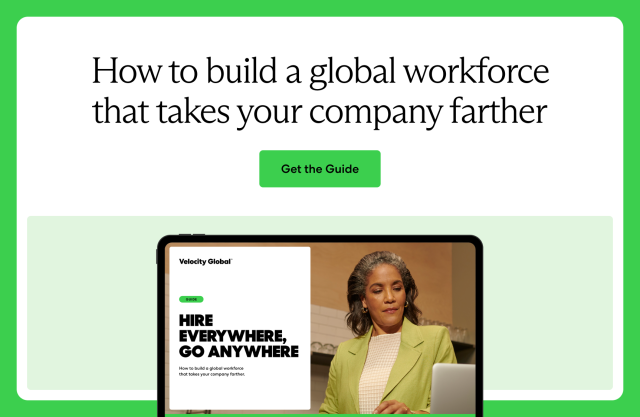A global workforce is a group of employees working for the same company but based around the world.
Global workforce refers to global or international remote workers of varying types. Companies pursuing global expansion should consider the nuances of engaging a global workforce since hiring and retaining globally distributed talent is complex.
Download our guide to learn how to quickly expand into new markets, hire highly qualified international talent, and ensure compliance at every step:

Types of global workers
The types of global workers an expanding company might employ are classified by how and where employees work and the nature of their responsibilities. Common categories include:
- Expatriates: These individuals relocate from their home country to work abroad, often with multinational companies or international organizations. Their assignments can span from a few months to several years.
- Remote workers: Also known as telecommuters, teleworkers, or virtual employees, these individuals perform jobs outside a traditional office environment, typically from home or shared workspaces. They rely on digital technology to stay connected with colleagues and clients and communicate and collaborate regardless of distance.
- Digital nomads: These professionals work remotely while traveling and living in different locations globally. Often freelancers, consultants, or business owners, digital nomads balance professional responsibilities with the opportunity to experience new places.
- Independent contractors: These self-employed individuals work on a project basis for clients and companies. Global contractors can work remotely and will often find and manage work via online platforms.
- Platform workers: These individuals generally serve companies that provide services to consumers via an online platform, such as a rideshare or delivery service.
- Short-term assignees: These professionals work on shorter-term contracts and assignments, often for multinational corporations, NGOs, or government agencies in different countries. They typically support specific projects or fill temporary skill gaps and are sometimes considered contingent workers who perform tasks without being formally hired.
- Seasonal workers: Often driven by seasonal demand, these individuals are temporarily employed abroad for short timeframes in industries like agriculture, tourism, and hospitality.
- Supported employees: These professionals are supported by an employer of record (EOR) on behalf of a company interested in hiring international talent. Because hiring employees abroad requires entity establishment, the EOR serves as the legal employer, hiring and paying supported employees on behalf of an organization so that the organization can forgo entity establishment.
Based on the country, there may be additional types of global workers. In India, for example, a “workman” refers to an industrial worker in a specific legal category.
Benefits of hiring a global workforce
Hiring a global workforce unlocks business opportunities for greater agility, innovation, and market reach. By employing talent from around the world, companies can gain advantages, including:
Access to global talent
A global workforce connects companies with skilled professionals and unique perspectives worldwide. Instead of relying on local talent, businesses can fill specialized roles and bring fresh ideas that enrich their teams.
A competitive edge
Global teams help companies expand market presence, boost revenue, and adapt to a competitive landscape. Team members with local knowledge enable businesses to make more strategic decisions to keep them ahead of the curve.
Reduced costs
Companies save on labor expenses by hiring in regions with lower living costs or outsourcing certain functions. This approach helps employers balance operational costs with maintaining high standards.
Simpler market expansion
Global teams bring critical insights into cultural norms, customer preferences, and local regulations. With in-market expertise, international companies can tailor strategies to resonate in new regions, making expansion smoother and more successful.
24/7 productivity
Companies with teams across time zones can keep work moving around the clock. A global workforce reduces project timelines, enhances customer support, and ensures someone is always available to handle pressing needs.
Innovation through diversity
A diverse workforce brings fresh perspectives to problem-solving and product development. Diversity helps drive innovation, allowing companies to create solutions and offerings that better meet the needs of a global audience.
Challenges of hiring a global workforce
While hiring a global workforce offers distinct advantages, this expansion also presents challenges requiring careful planning and resources. From navigating complex legal frameworks to fostering effective communication across borders, here are some hurdles companies may face when managing an international team:
Slower speed to market
Traditionally, international hiring and expansion are time-consuming, delaying market entry and securing critical international talent. Companies must navigate legal, regulatory, and logistical steps before establishing an international presence, hindering swift expansion.
Legal and regulatory compliance
Operating across countries requires companies to manage varied labor laws, tax regulations, and global compliance frameworks. Businesses must ensure they meet local labor laws, tax obligations, and global immigration requirements, all of which is time-intensive and costly without specialized knowledge.
Navigating cultural differences
Global teams often encounter cultural differences that impact communication styles, work expectations, and decision-making approaches. Companies must recognize these variations to prevent misunderstandings and foster a respectful, collaborative work environment.
Communication barriers
Working with a geographically dispersed workforce introduces challenges with coordination and collaboration, time zones, and language barriers.. Companies must invest in practical communication tools and practices to bridge these gaps and maintain team alignment.
Data privacy and security risks
Managing sensitive data across borders introduces complex security challenges. Global employers must comply with varying data privacy laws, such as the GDPR while implementing robust cybersecurity measures—the latter requires additional resources and expertise to maintain compliance and protect employee information.
Compliance risks to know when hiring global workers
Hiring in other countries introduces complex compliance risks that require careful management to avoid legal and financial issues. Here are critical areas to consider when building a managing a remote international workforce:
Employment laws
Employment laws vary widely by country, covering areas like minimum wage, overtime, benefits, and termination procedures. Companies must understand and follow these legal regulations to protect both employees and businesses.
Misclassification
Employee misclassification (for example, misclassifying employees as contractors or independent workers) exposes companies to legal risks, including potential lawsuits, fines, and obligations for retroactive benefits and taxes.
Taxes and payroll contributions
Payroll tax obligations, such as income tax and social security contributions, differ by country and require accurate payroll systems to avoid penalties. Timely, compliant payments are essential for maintaining both employee trust and regulatory adherence.
Permanent establishment
Companies that employ staff in foreign countries and become permanent establishments can expose the business to corporate tax obligations. To prevent unexpected tax liabilities, employers need to understand the thresholds for permanent establishment.
Data security
Data privacy laws, like GDPR in Europe, regulate how companies collect, store, and share employee data. To ensure compliance with these standards, global companies must employ secure data management practices, especially when handling sensitive information across borders.
Immigration requirements
Hiring internationally often involves navigating work permits, visas, and other immigration documentation. When companies fail to meet these requirements, the result can include fines, legal restrictions, or even employee deportation.
Tips on how to manage a global workforce
Despite challenges, with the right strategies in place, global companies can create supportive, cohesive work environments that maximize the benefits of any international team. Here are essential practices to help manage a global workforce effectively:
Embrace cultural sensitivity and awareness
Show respect for cultural differences within the team by investing in cultural awareness training for managers and employees. Encourage an inclusive, collaborative environment where team members feel valued as individuals.
Establish clear communication channels
Set up consistent communication channels that support both synchronous and asynchronous interactions. A mix of video conferencing, email, and collaboration platforms can keep everyone informed—and be sure to establish clear communication protocols that help bridge time zones and language differences.
Build trust across borders
Foster trust and rapport by encouraging open communication, transparency, and mutual respect. Invest in relationship-building activities, like virtual team-building exercises and informal chats, to strengthen connections and enhance team cohesion.
Set clear expectations
Managing a global workforce efficiently requires employers to specify roles, responsibilities, and expectations for each team member, regardless of location. Companies that establish measurable KPIs and milestones can more easily keep team members accountable and provide a shared sense of direction.
Provide a robust benefits package and competitive pay
Global employers should offer compensation and benefits that meet or exceed local market standards, including health insurance, retirement options, and paid leave. Ensuring fair, competitive employee benefits packages across regions supports recruitment and retention and promotes a positive, loyal team culture.
Support ongoing training and development
Offer training that addresses the skills needed in a global environment, including cross-cultural understanding and language learning for those who need it. Companies that offer development resources help promote career growth and equip team members to excel internationally.
Promote diversity and inclusion
Cultivate a company culture that values diverse perspectives and actively seeks input from underrepresented voices. Global employers should invite participation from all team members and aim to create a welcoming environment that fuels creativity and innovation.
Offer flexible work arrangements
Companies that expand globally must work to accommodate different time zones, cultural norms, and personal preferences. Employers that offer flexible scheduling, remote work options, and family-friendly policies are more likely to attract and retain high-demand global workers. Employers that support work-life balance in this way contribute significantly to employee satisfaction and overall well-being.
Encourage collaboration and teamwork
Create opportunities for virtual meetings, brainstorming sessions, and collaborative projects to foster teamwork across locations. Companies that do this successfully often use online platforms to facilitate real-time collaboration and seamless document sharing.
Effectively manage time zones
Stay mindful of time zone differences when scheduling meetings and deadlines. Scheduling tools can help teams identify convenient times for all participants. Rotating meeting times can also accommodate employees in all regions more fairly.
Partner with an EOR
Partnering with an EOR allows companies to quickly and compliantly hire, pay, and manage global talent without setting up a local entity or building in-country HR teams. An EOR like Velocity Global handles everything from onboarding to global payroll, global benefits, and offboarding while navigating complex labor laws on a company’s behalf, reducing financial, legal, and administrative burdens so businesses can quickly build their dream workforce.
Contact Velocity Global to learn more about how our EOR solution opens the doors quickly to new markets and makes it easy to hire and retain a global workforce.



